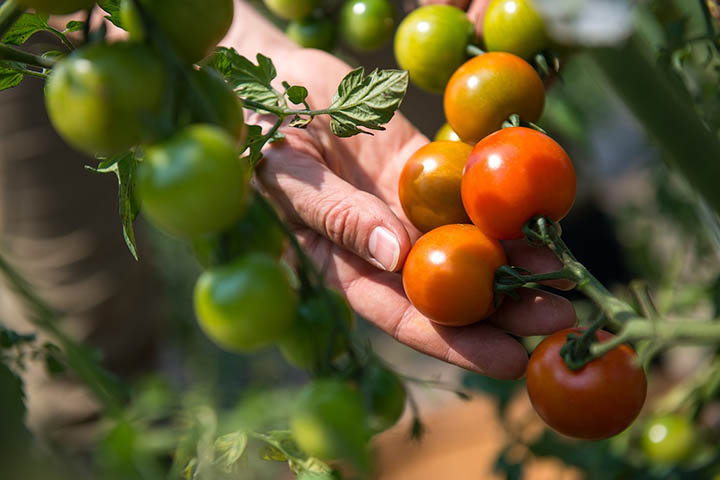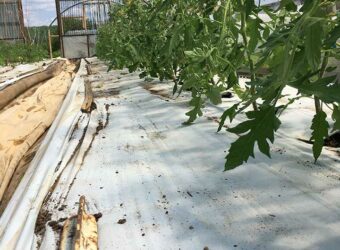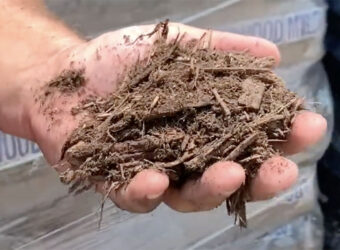If you’re trying to decide what type of tomatoes you should grow, you may run across the words determinate and indeterminate. These two terms refer to a tomato plant’s growth habit.
While you may think tomato size or color is the most important factor to look for when you’re choosing which tomato varieties to grow, I find growth habit is equally important.
Wondering why? Then keep reading!
I’m going to detail the differences between determinate and indeterminate tomatoes so you can choose the type that is best suited for you.
Differences Between Determinate and Indeterminate Tomatoes
As mentioned above, the terms determinate and indeterminate refer to a plant’s growth habit. However, this involves more than just the plant’s size and shape.
Height
One of the main differences between these two types of tomatoes is their height.
Determinate tomato plants will grow to a certain height and then stop growing. This growth form applies to both the main stems as well as suckers that appear between the stems and leaves.
The maximum height depends on the particular determinate tomato variety, but many types max out at between four and six feet tall.
Indeterminate tomatoes will continue growing as long as they have the elements they need to be healthy. In many cases, these tomatoes will continue to grow until disease or a frost kills them.
I’ve personally seen indeterminate tomato plants grow over 20 feet long in a greenhouse! However, when grown outdoors in a typical garden, the plants are more likely to reach around 6 to 10 feet.
Fruit Production
Another difference between determinate and indeterminate tomatoes is how and when they produce fruit.
Once determinate tomatoes reach their maximum height, they transition their energy from producing fruit to producing flowers. That means all of the flowers are produced in a short period.
After the flowers are pollinated, fruit begins to form. Since the flowers were formed over the course of a few weeks, the same applies to the tomatoes.
Since determinate tomato plants produce all their fruits in two to three weeks, you need to be ready for a short yet big harvest!
I find that this means that determinate tomatoes are great if you want to make sauce or complete a canning project. However, they’re not the best option if you want to harvest a handful of tomatoes to snack on each week throughout the summer.
If you prefer smaller harvests over a longer period, indeterminate tomatoes are a better choice. As indeterminate tomatoes continue to grow, they also produce more flowers and fruits.
You can expect indeterminate tomatoes to produce fruits over the course of multiple months.
I’ve found that as long as the plants are healthy, I can expect to pick tomatoes for about four months. However, fruit production and/or quality often slows down later in the season.
Which Are Better: Determinate or Indeterminate?
My honest answer is that one type is not better than the other! It all depends on what you’re looking for.
For a Low-Maintenance Plant
If you prefer a low-maintenance tomato plant, I’d go with a determinate variety.
The plants don’t require trellising and can be left to sprawl over the ground. However, if you want to support the plants, a simple metal tomato cage will do the trick.
Determinate plants also perform well without pruning and won’t get out of control, they can grow well in pots. Indeterminate plants on the other hand are likely to become overwhelming tangles of vines if they’re left unpruned.
Determinate plants are also a great choice if you have mobility issues or a busy schedule!
For Continuous Fruit Set
Looking to enjoy cherry tomatoes on your salads or big slices on sandwiches throughout the summer? Then go with an indeterminate type.
These varieties will continue to produce tomatoes for months, allowing you to get your fill of tomatoes during July, August, and September.
For Preserving Projects
If you hope to can jars of salsa or can whole, peeled tomatoes, determinate varieties are your best choice. Since they set fruit over the course of a few weeks, they provide you with a large amount of fruit over a short period.
One healthy plant typically produces around 10 to 12 pounds of tomatoes over two to three weeks.
Indeterminate tomatoes will work perfectly fine for tomato sauce, salsa, and the like. However, you will have to plant more than one indeterminate plant if you want enough tomatoes for more than just one jar of sauce.
Pruning and Trellising Determinate and Indeterminate Tomatoes
As you know by now, one of the big differences between determinate and indeterminate tomato plants is how they grow. And that means that the two different types of plants can benefit from different pruning and trellising.
Pruning and Trellising Determinate Tomatoes
Since determinate tomatoes can remain quite small and compact, you don’t need to trellis them. However, I find if they grow over four feet tall, they can benefit from some type of support.
Trellising the plants will help prevent disease by keeping the foliage off the ground. It can also make it easier to harvest the tomatoes.
One way to trellis determinate tomatoes is via a stake and twine. This involves inserting a stake into the ground next to the tomato plant and tying the main stem of the plant to the stake as it grows.
Alternatively, you can place a standard metal tomato cage around the plant when it is still small. The cage will help to support the plant and keep the fruit off the ground.
Similarly, you don’t need to prune determinate tomatoes. However, pruning can help prevent disease and also increase fruit production.
If you’re only going to complete one pruning step, remove the lower leaves. These leaves are the most likely to come in contact with the ground or splashed soil, so removing them can help prevent diseases from developing.
Pruning off some of the plant’s leaves will increase airflow, which can also prevent the development and spread of fungal diseases.
Pruning and Trellising Indeterminate Tomatoes
Remember how I said indeterminate tomatoes were a bit more work? Pruning and trellising account for the majority of this increased labor.
Sure, there’s no rule saying that you have to trellis these taller plants. But if you forgo providing some type of support, you’ll be left with a mess of sprawling vines (and more than likely diseased leaves and rotten fruit).
Trellising will help keep your plants better contained and organized. Not only does this make it more enjoyable to deal with the plants, but it also frees up valuable garden space.
Since trellising keeps the tomato plants off the ground, it helps prevent the development and spread of disease. Plus, it makes pruning the plants and harvesting the tomatoes much easier.
When it comes to trellising, you can choose from multiple methods.
Florida Stake and Weave
My preferred method of trellising is known as the Florida stake and weave. It gets its name due to its extensive use in Florida tomato fields.
This method can be used for one plant in a garden or hundreds of plants in a field. That said, it works best for tomatoes that are planted in a row.
To trellis your tomato plants using this method, follow these steps:
- Insert wooden stakes or metal t-posts that are at least six feet tall on either side of a tomato plant. If you are growing multiple plants in a row, you can space the stakes every three or four plants.
- Ensure that the stakes are at least six inches into the ground. The stakes should not budge when you gently wiggle them with your hands.
- When the plants are about a foot tall, run a string of tomato twine between the stakes on one side of the plant. Complete this step on the other side of the plant. When you’re finished, the tomato plant should be sitting between two pieces of twine.
- When the plants have grown about a foot above the first line of twine, add another line about 8-10 inches above the original.
- Continue repeating this process until the twine reaches the top of the stakes.
It’s important to note that you may need to tuck side shoots, aka suckers, under the twine as you trellis.
Also, once the tomato plants grove above the top of the stakes (they will), simply let the vines flop to one side.
Tomato Cage
If you want to contain your plant using an easier method, you can use a metal tomato cage. The plants will outgrow the cages, but they will not be sprawling all across the ground.
Ensure that you choose the tallest cage you can find, and insert it when the plant is small.
Note that a tomato cage can make it difficult to prune your plant. It can also make harvesting a bit more difficult, so I don’t recommend using tomato cages on indeterminate cherry tomato plants.
Pruning
As with trellising, you technically don’t need to prune indeterminate tomato plants. If you forgo pruning, the plants will still grow and produce tomatoes.
However, I find that pruning these larger tomato plants has many advantages.
First, pruning off excess leaves helps increase airflow. This can help prevent the development and spread of fungal diseases such as early blight and Fusarium wilt.
Pruning off side shoots, aka suckers, will also help increase airflow. It can also help keep the plant more manageable and make harvesting easier.
So, how should you prune?
I like to start by removing any lower leaves that are touching the ground. This can be done at any time.
Next, I focus on suckers. These are the offshoots that form at the elbow joint between a main stem and a leaf.
If you’re trellising with a tomato cage or the Florida weave method, remove the suckers on the bottom two feet of the plant. This will help keep the plant more manageable and also allow the plant to focus on vegetative growth when it is young.
It’s true that pruning off suckers will decrease total possible fruit production. However, I find that you’ll still end up with a large number of tomatoes.
Types of Determinate and Indeterminate Tomatoes
Now that you know the differences between these two types of tomatoes and how to care for them, here are some popular varieties of each type.
Determinate Tomato Varieties
For a more extensive list, as well as information on each variety, check out our favorite list of determinate tomato varieties.
Indeterminate Tomato Varieties
To learn more about these varieties as well as some others, head over to some of the best indeterminate tomato varieties.
Frequently Asked Questions
Still want to learn more about these two types of tomatoes? Stay with us as we answer some frequently asked questions.
What Are Semi-Determinate Tomatoes?
Along with determinate and indeterminate tomatoes, there are semi-determinate tomatoes.
Some of these varieties are technically indeterminate that remain shorter while others are determinate varieties that grow a bit taller. Therefore, the fruit set patterns depend on the exact variety.
Are Cherry Tomatoes Determinate or Indeterminate?
It depends on the variety! While many cherry tomato varieties are indeterminate, others are determinate.
Therefore, you should research each variety before you grow it.
Are Heirloom Tomatoes Determinate or Indeterminate?
Once again it depends on the individual variety. Some heirloom tomatoes are indeterminate while others are determinate. For those who love growing heirloom tomatoes in the garden, read to know how I grow heirloom tomato plants.
What Type of Tomato Produces All Summer?
All types of indeterminate tomatoes can produce fruits all summer! As long as you provide these plants with the proper environment and care, they can produce fruit over the course of three to five months.
You can find cherry tomatoes, heirlooms, and beefsteaks that are indeterminate.
Should I Grow Determinate or Indeterminate Tomatoes?
Unfortunately, there isn’t an easy answer to this question. It just depends on what you’re looking for.
If you want a low-maintenance plant or have a small garden space, determinate tomatoes are a better choice. These varieties also work well if you want a big harvest for canning.
However, indeterminate tomatoes are a better choice if you want to enjoy tomatoes all summer long.
Don’t forget to check out our in-depth guide for everything you need to know about growing tomato plants.






